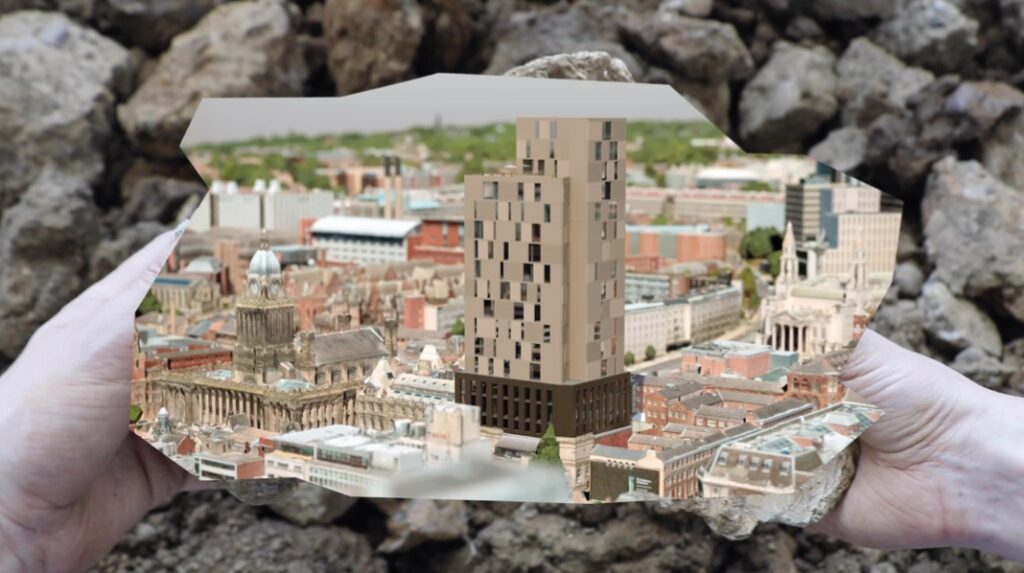Archiving Encounters is a series dedicated to the exploration of archives in contemporary art practices. This series takes conversations with artists, and their practices, as starting points to encounter the different kinds of archives they choose to work with. Often artists use ‘the archive’ as a theme itself, produce new taxonomies, respond to real archival materials to critically challenge modes of knowledge production, or use it as a framing device to invent characters or events from the past that are put in dialogue with the present to shed new light on contemporaneity. In this sense, archives become building sites to create new narratives. In the last article, Eleonora Roaro’s work puts in dialogue micro-stories with historical narratives, questioning the hidden power structures of institutional and private archives. By digging out what is there, the artist brings attention to the invisible traces and the gaps left by what is not there, using the archive as a mirror for something else. By researching what is to be seen, the artist reflects on her positionality and on who is seeing and, ultimately, also questioning our own place of spectatorship. In this issue, we explore how casting is used as a method to document spaces and create new archival materials while it is also used to rearrange the existing archive and explore the unrealised possibilities of places and spaces. James Thompson’s practice deals with the perception of space and its interpretation, working across sculpture, moving image and site-responsive performance, the artist records and re-interprets pre-existing spatial situations as the starting point to construct new multidimensional experiences of reality.
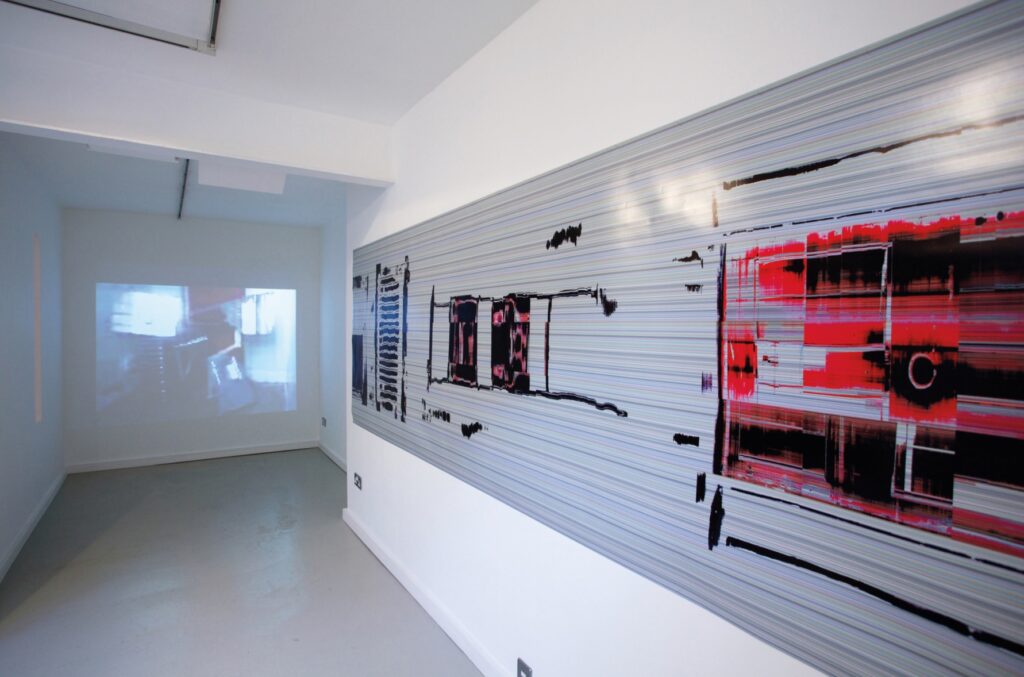
James Thompson is a Leeds (UK) based artist. His practice mixes sculpture and performance to engage with lost futures and failed dreams, it explores and brings to life the alternative version of unrealised histories of space. This journey started with recording the space in between the objects of the café of the Royal College of Art, to understand how the architecture and the furniture give shape to a space, and how people use it, their experience of that place. He used casting as a way of mapping that space in between and re-imagine its potential parallel versions. How could the distance between the table and the wall be reused or reappropriated? Continuing to work with this kind of approach, his subsequent work has branched from it. It is during that period that he started to document his process with a fixed camera, another layer of documentation that later has become more incorporated with the work.
Interested in multiverse thinking and quantum physics of parallel worlds, he uses casting to capture the different dimensions of space and time as the fourth dimension of reality. By applying jesmonite with a paint brush, every two strokes that moment of time is physically captured in the work as the jesmonite sets. Its thin application allows us to see the positive and the negative dimension of space. For example, for the exhibition Expanding Spaces (2013), he worked in one of the cells of High Royds, a former psychiatric hospital in Menston (West Yorkshire) that was going to be renovated into luxury accommodation after almost 10 years of being closed. Almost like a village within a village, it had a cricket club, a library, surgery, a bakery shop, upholster and cobblers workshop and even its own railway station. He was given cell number 4, one of the former patient rooms that could be accessed mainly in the evening as the space was being used as a sports and social club.
“During those times I used as many different processes to record that space as possible, to open up to multiple dimensions and the space was in transition so I wanted to imagine the parallel worlds within that particular environment”.
In Rotating Space, he used latex to map the perimeter of the room, where each of the corners of the cell is marked by a high-frequency audible signal. This work is mounted on a rotating belt that moves at a tenth of the average walking speed of a person, so by reducing the speed of travel around the room, he wanted to distort and expand the dimensions of the room. Re-constructed Space comprises a shelf-like structure and architectural table that arise from the recording of distances within the space by means of jesmonite and fibreglass casts. In the case of the shelf-like structure, the largest section of jesmonite is the negative form of the run from the door frame to an adjacent curving wall and on into a right angled corner. This part of the room has been up-ended and re-assembled to include a section of window frame.
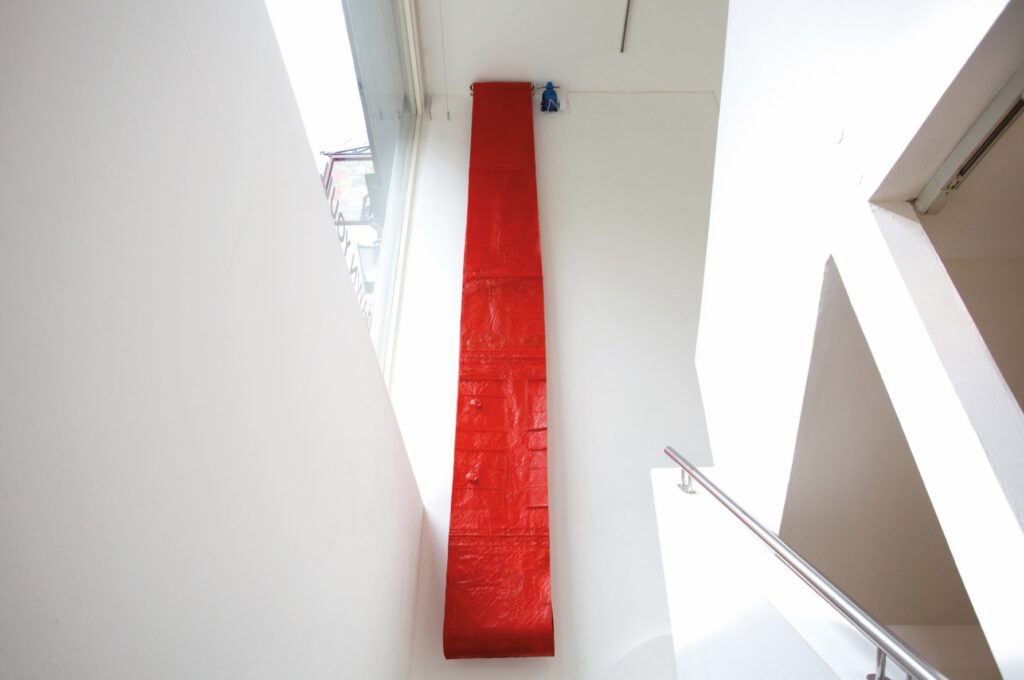
This process was also about endurance, in 1 hour 53 minutes, two seats of bright blue silicone rubber supported by reconstituted foam blocks are made by pressing his body weight against shapes within the cell. This process was lengthy and repetitive, pushing his own body to push the space in becoming something else. With From Window to Door, Thompson used a flatbed scanner from a printer to make a hand-held scanning device. The scanner has a certain speed of movement which is fixed to the motor which creates an image which appears real but by making it handheld. He could scan things at different speeds. The resulting images would be stretched or compressed depending on the speed of movement, in a similar way in which he used the paintbrush to cast features of the room and create an alternative version of that space.
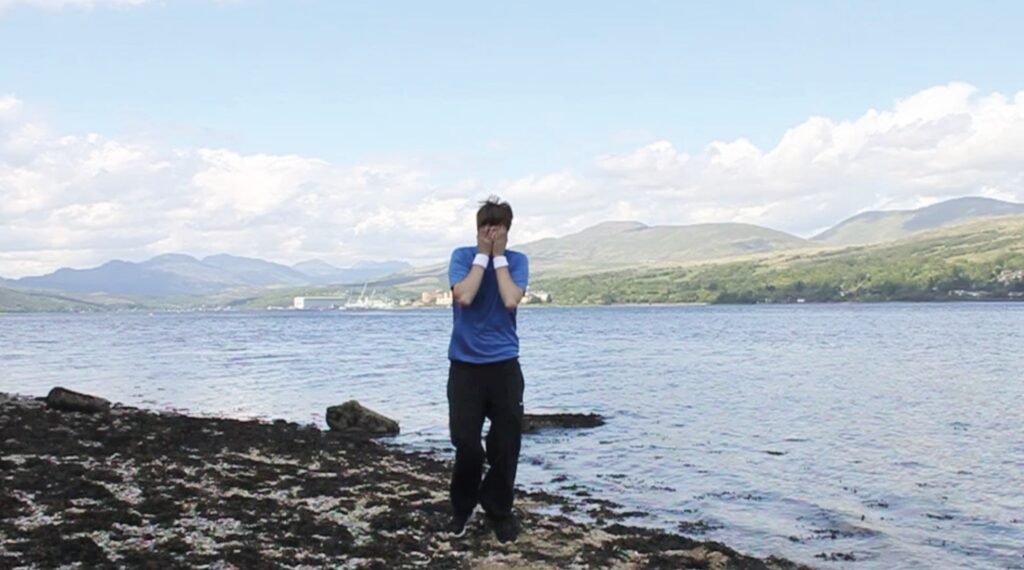
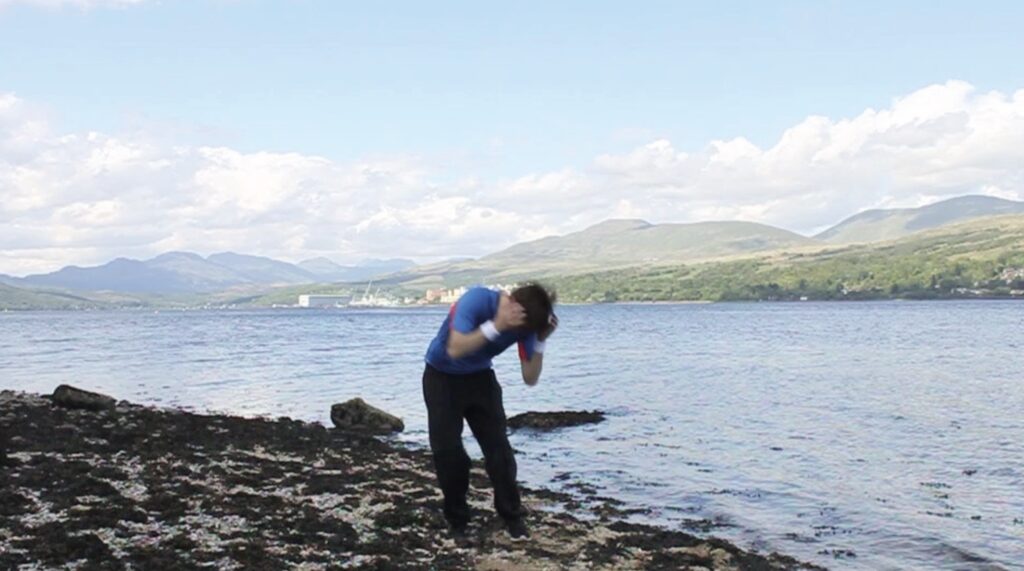
Performing the casting process is dictated by the space which is an archive in itself by being a spatial repository but this process is also generative through the distortion and duplication of the copies created which give life to an archive of the alternative dimension of the space. Intrigued by the agency of his own body in compressing space and time, the artist produced other work that this time saw the video recording of performative acts as an output itself rather than solely a documentary material.
A similar work, where the indications for the performance movements are found in archival materials is Emergency Defence Exercise Video (2014). With this work, he again tested his endurance through repetition to challenge, create and alter the meaning of space. During the residency at Cove Park, in South-West Scotland, he researched videos from the BBC archive and in particular the “Protect and Survive” infomercials that were broadcasted during the Cold War by the government to prepare the population in the event of a nuclear attack. This material was used to choreograph an exercise routine from body brace and other defensive positions, which he performed on the banks of the Gare Loch near the residency space and opposite the Trident Nuclear Weapon base. Similar to the work at High Royds, this work involved endurance as the process was based on repeating the exercises for several hours. The body is used as a means for duplication: while the slow process of casting made use of the architecture to create a new object, here the replication of particular movements is a means to connect them by rearranging them and performing them in a new context.
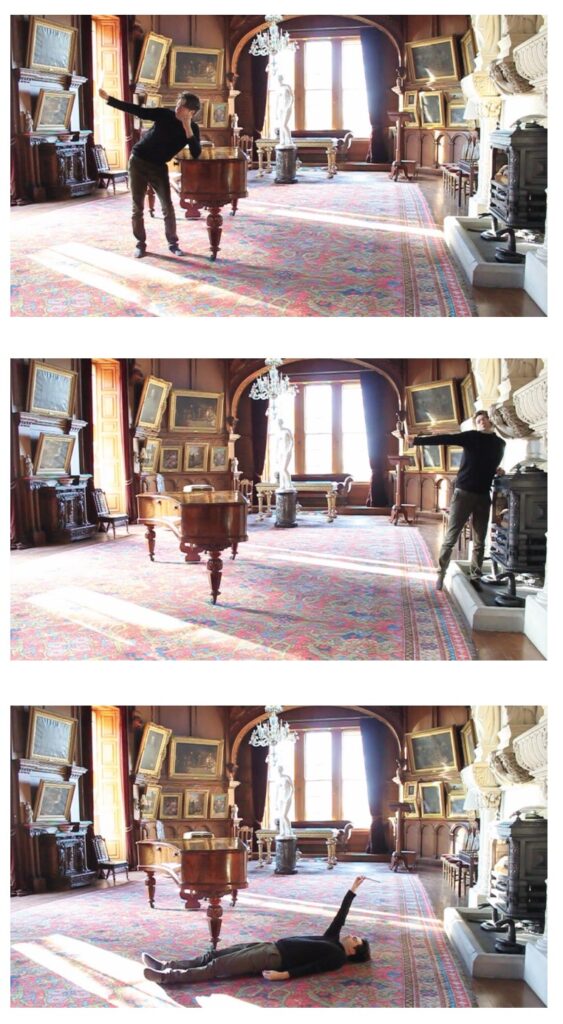
The idea for the video performance Self-Digitalisation (2015) continues this work by using the body as a vessel, or better, a point of conjunction to merge past and future self-documentary interactions with the space. This work engages with the Picture Gallery at Hospitalfield. Inspired by the classical statues, the portraits and the way in which they posed or stood as the perfect way to be represented, the artist moves to find the perfect position and pose to take a selfie. In search for the idealised position that allows for an optimal version of self-representation similar to the ones of the subjects of the artworks, a connection is made between historical approaches to self-representation and contemporary one.
The connection between time and space continued with a long-term project in collaboration with Leeds Art Gallery. In 2017, the Central Court of the Gallery was being renovated and James continued his enduring performative work by casting the space. This casting process becomes a method of archiving the ‘old’ space and by performing it while in transition the artist works with the possibility of the liminal condition of the space when it is not what it was and it is yet to become. After a few years of developing and experimenting with this process, the solo exhibition Spatial Drifts (2021) in the renovated space of the gallery allows the use of the exhibition space as a multidimensional space that plays with spatial lines and the linearity of times by morphing and re-interpreting them. In the exhibition, another dimension of the Central Court is on show, space and time are re-cast and reassembled: the dimension of certain features of the room is expanded again through inflatable structures and its elements are re-configured in the alternative archive of the possible versions of the space when it was in transition.
The idea of alternative realities expanded outside of the gallery to the city. As part of the exhibition, Thompson produced ‘Sixty Skylines Walking Tours’ around the city, which he performed with the Leeds based artist Kp Culver. To collate materials for this performative walk in the public space, the artist resorted to archival research of published materials and accounts but also interviewed artists on the lost art space and studios in one mile radius of the Leeds Art Gallery. In the last one hundred years, the value of the land increased, making spaces for artists more precarious and causing the loss of about 60 art spaces. The two artists performed dialogues to narrate the present and alternative history of those places, from the point of view of the artists and their development into new spaces from the perspective of a property developer to present alternative visions of each site. This critical approach was brought back into the space of the gallery, where the film Re-Imaging Central Court (2021) portrays the fictitious re-development of Leeds Art Gallery into luxury accommodation with a roof terrace reflecting on the nature of urban development in the city contrasting it with shots of building sites and the earth dug from a local construction site, where art spaces used to be.
“This work investigates potentials through the use of CGI imagery usually used in architectural visualisations to communicate a new future as a precursor to action and through the residual value of earth dug from a Leeds construction site, a future in progress.”
The artist found himself grappling with the production of the archive and the loss of memory and history in the city with Recording Performance (negative) (2019). Currently, the Leeds Town Hall stands in front of a carriageway and a car park but once that space was occupied by several statues: Memorial to Queen Victoria, Statue of the Duke of Wellington and Sir Robert Peel. Now situated on Woodhouse Moor in Leeds, Thompson worked with Samra Mayanja to produce 114 clay moulds of their features that were smashed on the floor in the original location of the statues. This work engages with the ideas of lost futures of a place while it connects to its actual alternative present in another context.
The most recent work Re-Positional States (2023) continues to bridge time and space with a video produced with different film strategies. The video starts by showing the interior of United Reformed Church in Saltaire Village, a UNESCO World Hertage Site in West Yorkshire. This site is explored because it stands as a church heavily influenced by 16th-century Italian architecture and brings together various architectural elements observed during the travels by Sir Titus Salt, who commissioned it. By re-arranging elements that already create an alternative version of architectural sites that exist somewhere else. I started to engage with James’ work when he asked me to translate and do the voice over for the description of the church found in the hand-out at the site.
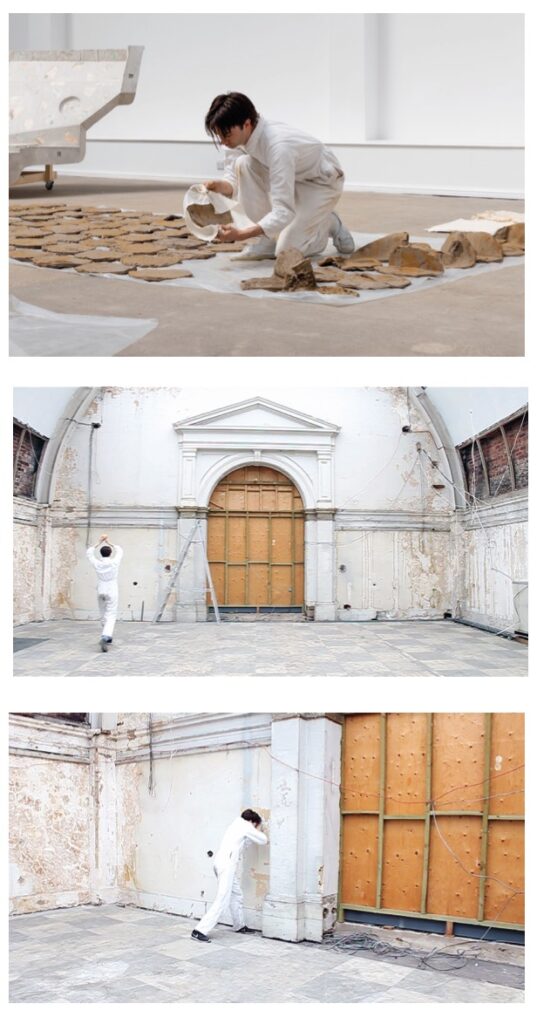
Sir Titus Salt was an important figure in the second industrial revolution in Great Britain, becoming the biggest employer in Bradford, one of the industrial centres in the region. He commissioned the construction of Salt’s Mills and the village of Saltaire to provide his workers with better living conditions than the slums of the city. After giving an overview of the decorative elements of the church and the mausoleum in which Titus Salt was buried. The camera starts spinning inside the church horizontally and the image is overlaid with the vertical spinning of the filming of the church from the outside to create a warp hole effect that transports the viewer into a space in between, outside of time. Scans of the Memorial to Queen Victoria statue in Leeds flow in the background as a way to reconnect the place to the macro-economic and social dimension of time that gave rise to the building and are connected to the development of the idea of the empire and a still-standing Victorian construction of the idea of Britishness. The industrial revolution serves as a backdrop to connect to more recent times, the voices of Italian textile workers that emigrated after the second world war can be heard. These fragments were drawn from the archival interviews originally recorded in 1984 by the Bradford Heritage Recording Unit.
From the interviews, there is a strong sense that this migrant community did not entirely feel they belonged to Britain with a feeling of longing for what was their memory of Italy. At the same time, they did not fully integrate with their original communities after building a life in the UK: they remain in a limbo between two places. In 2019, the BBC did a follow up interview after the 2016 Brexit vote and this condition became more evident as after 60 years of constructing an identity in the country, their position was made precarious by the lack of paperwork that was needed to prove their right to stay in the country. The narrative of the film unfolds through various temporal lines: my young voice Italian migrant, the 154 year old church, the voices of post-war migrants 30 years ago and their renewed perspective from 4 years ago. Casting the factual description of the church with distorted copies of other spaces and the archived voices of migrants created a suspended dimension in which micro and macro temporalities intersect to create a parallel world.
